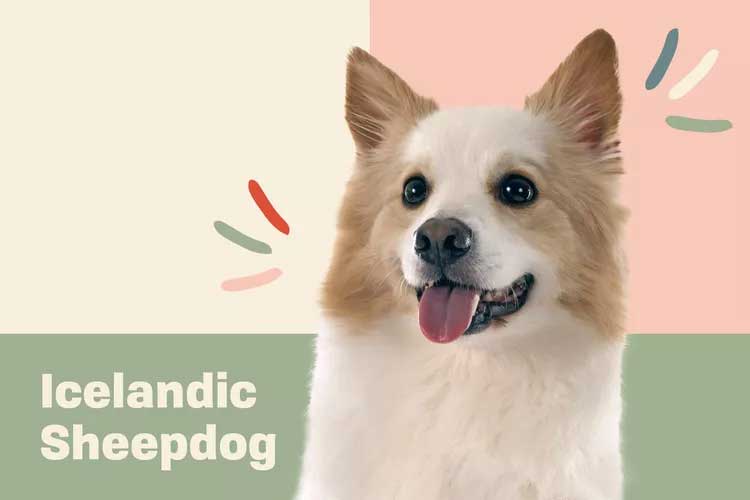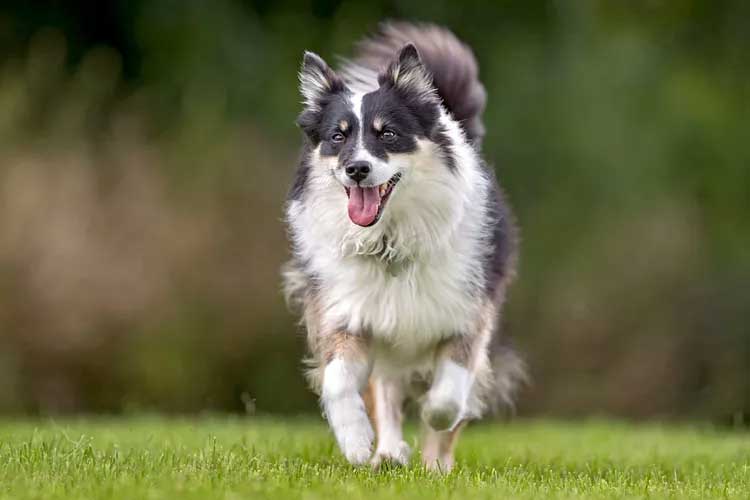The Icelandic sheepdog is a friendly, intelligent, and high-energy dog who is loyal and playful with her family. Learn more about living with the Icelandic sheepdog.

Icelandic Sheepdog Overview
| OFFICIAL NAME | Icelandic Sheepdog |
| COMMON NAME | Icelandic Sheepdog |
| PET HEIGHT | 16 to 18 inches |
| PET WEIGHT | 25 to 30 pounds |
| LIFESPAN | 12 to 14 years |
| GOOD WITH | cats, children, dogs, seniors |
| TEMPERAMENT | friendly, playful, willful |
| INTELLIGENCE | high |
| SHEDDING AMOUNT | normal |
| EXERCISE NEEDS | high |
| ENERGY LEVEL | active |
| VOCAL LEVEL | frequent |
| DROOL AMOUNT | low |
| BREED GROUP | herding |
| BREED SIZE | medium (26-60 lbs.) |
| COAT LENGTH | medium |
| COLORS | black, brown / chocolate / liver, cream, fawn, gold / yellow, gray, red, white |
| PATTERNS | bicolor, sable, tricolor |
| OTHER TRAITS | cold weather tolerant, easy to train, good hiking companion, loves water, strong loyalty tendencies |
The Icelandic sheepdog is a cheerful, friendly, inquisitive, playful, and confident dog who is incredibly loyal to her family. Standing between 16.5–18 inches at the shoulder and weighing between 25–30 pounds, she was bred as a herding dog, but there's no place she'd rather be than with her family.
Friendly and highly adaptable, the Icelandic sheepdog is full of energy and needs moderate daily exercise to keep her curled tail wagging. Take her along on a long walk or hike through the woods, and she's happy. Or, run her through dog sports and events like agility, herding, obedience, tracking, and rally to watch her shine.
Appearance
If you spot an Icelandic sheepdog at your local dog park, you may think she's a Pomeranian or German spitz, and for good reason. The breed is one of about 50 breeds classified as spitzes, each characterized by a dense coat, foxy face, pointed ears, and a tail that curves cutely over their back.
The Icelandic sheepdog is a medium-sized breed weighing less than 30 pounds. She has a double coat: a longer outer coat and a dense undercoat. The breed's coloring can be black, cream, fawn, gold, grey, red, sable, tan, or chocolate, always with white markings.
Perhaps the most endearing quality of the Icelandic sheepdog is her face. Her dark brown almond-shaped eyes and perky ears give her an expression that's always friendly and happy.
Temperament
Though she's bred to work as a herding dog, the Icelandic sheepdog (or "Icie," as her adoring fans call her) is just as happy as she looks. Icies are also loyal, intelligent, versatile, affectionate, and often eager to please."Icelandic sheepdogs are an affectionate, outgoing, cheerful, and friendly spitz breed," says Cherice Roth, DVM, veterinary expert with Fuzzy. "They're a good breed for a family pet as well as an outdoor working dog initially bred for sheep and medium-sized livestock herding. They are very sociable and gentle, once exercised, and great with children and other pets."
Loren Dribinsky, founder and president of the board of directors of National Icelandic Sheepdog Rescue Alliance (NISRA), agrees.
"Icelandics can be wonderful family dogs," Dribinsky says. "They are happy meeting strangers and children, and when they are with their family they are so happy.

"Temperamentally, they are loving, eager to please, and responsive to positive training techniques, but prone to separation anxiety if they are not socialized and [if] they are left home alone for long periods of time," she adds. "They love to accompany their owners to work, and quite a few have been service dogs. On the other hand, they are very attuned to the moods of their owners, and an anxious owner can produce an anxious dog."
Living Needs
Icelandic sheepdogs can live successfully in an apartment if they are well-exercised and trained, Dribinsky says, but you might want to think twice if your Icie tends to express herself loudly (as many of them do)."Although an Icelandic sheepdog is a medium-sized dog, they do have the bark of a larger dog," Dribinsky says. "The tendency to bark varies from dog to dog but can be a problem for some neighbors."
Roth says that because Icelandic sheepdogs were bred to be working dogs, they are prone to "vocalization-first expression." So it's important for owners to begin training their Icelandic sheepdog puppy early and focus on introducing "inside voice" commands.
"As a smart, strong-willed dog, this may be tricky to reinforce over the long term and is a consideration pet parents should make prior to bringing an Icelandic sheepdog into the home or apartment," Roth says.
Icelandic sheepdogs typically do very well living alongside other dogs. Because of their herding instincts, they might try to round up the family cat, but can live well with kitties if properly introduced. If they're raised with feline siblings, even better! Icies also make great playmates for children, but, as with all breeds, puppy playtime should be a supervised affair and kids need to be taught how to properly interact with dogs.
Care
Caring for your Icelandic sheepdog is fairly straightforward, but there are a few times a year when you'll need to up your grooming game. She does shed regularly, and even more so during spring and fall shedding seasons. To keep the fur from flying, weekly brushings—and daily brushings during shedding season—will remove any dirt and loose hair, keeping her feeling (and looking!) good."Both short-haired and long-haired Icelandic sheepdogs have double coats, which can cause seasonal shedding issues for some parents and, left ungroomed, can lead to unhealthy matting and other health issues," Roth says.
As with all dogs, take the time at home to ensure your Icelandic sheepdog's ears are free of infection, her nails are trimmed for comfort, and her teeth are brushed often.
When it comes to training your dog Dribinsky says, "the best way to train an Icelandic is to use positive reinforcement methods like clicker training with treat or toy rewards. Icelandics are intelligent, love to please, make good eye contact, and bond deeply through their training interactions with their owners."
And while Icies are friendly and make terrific companions, first-time dog owners should perhaps shy away from an Icelandic sheepdog until they have more experience under their belts.
"Because of their intelligence, occasionally high activity level, and preference for being with their owners all the time, they are not the best dog for the first-time dog owner," Dribinsky says.

Their smarts and attentiveness mixes well with their playful nature and "let's go!" attitude—Icies were bred for endurance—to help them excel in outdoor activities.
"The quick brains and active traits of herding dogs like Icelandic sheepdogs means that these dogs need plenty of exercise and stimulation," Roth says. "They are not an ideal breed to leave home alone, indoors, unsupervised for extended periods of time. They best respond to puzzles, agility courses, scent training and work. They're also very people-oriented, so social interaction and positive reinforcement are essential when training. These dogs love being aside humans for hikes, long walks, runs, or agility training."
Health
Icies have a lifespan of 12–14 years and are generally healthy dogs. But, as with all breeds, there are a few conditions pup parents need to keep an eye out for."They can be prone to joint health and tendon issues in their back, hips, and elbows as they age," Roth says. "Preventative care with strength, agility training, and joint health supplements as the dog enters her adult, but not yet senior, years can help to minimize these health issues."
Visit the veterinarian for regular checkups and vaccinations, and consult your vet if you notice any changes in your dog.
History
The Icelandic sheepdog was likely brought to Iceland from Norway in 874, where the breed was used to herd sheep, cattle, and ponies, according to the NISRA.Fast forward a few hundred years and, in 1555, the breed was popular among priests and the upper class. A few decades later, the dogs became popular with the British aristocracy. By 1869, the estimated dog population in Iceland was around 24,000. But famine, epidemics, and a law that taxed dogs made the Icie's population decline and by the 1960s, they were in danger of extinction.
Dedicated breeders revived the Icelandic sheepdog population, and the American Kennel Club officially recognized the breed in 2010.
Fun Facts
An Icelandic sheepdog is mentioned in William Shakespeare's play "Henry VIII."It's believed that all Icelandic sheepdogs today are the descendants of 23 unrelated dogs.
Icelandic sheepdogs have been trained as search and rescue dogs.